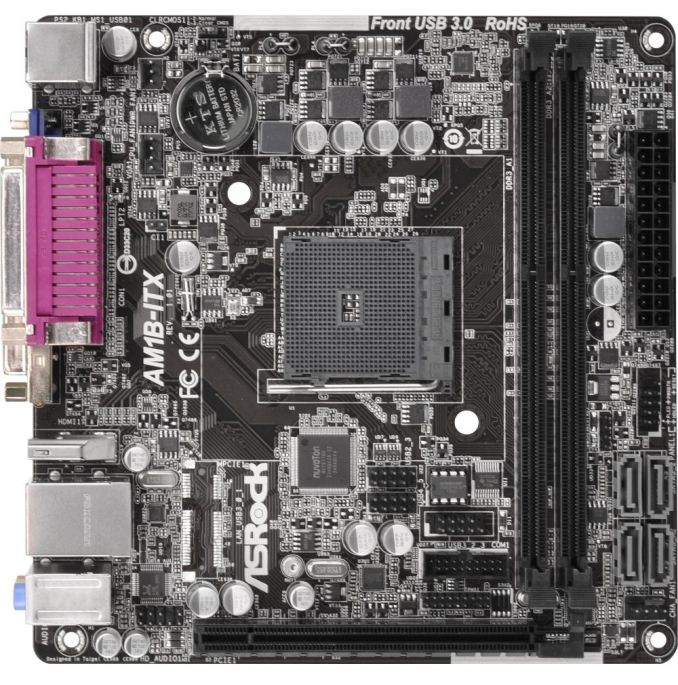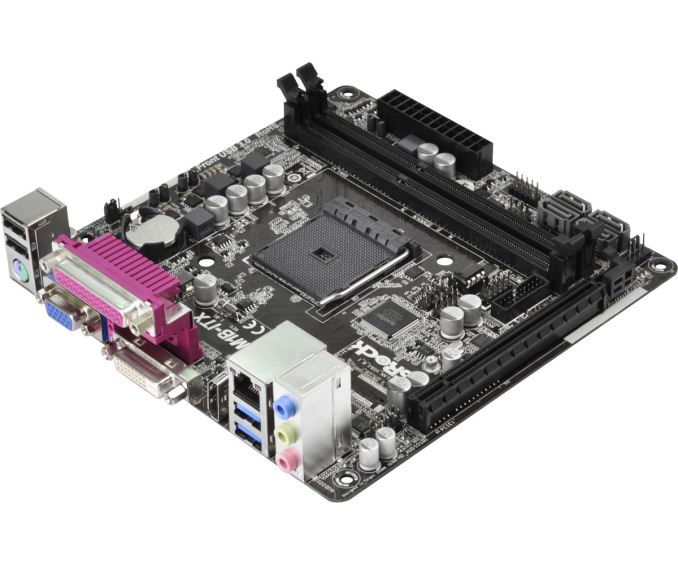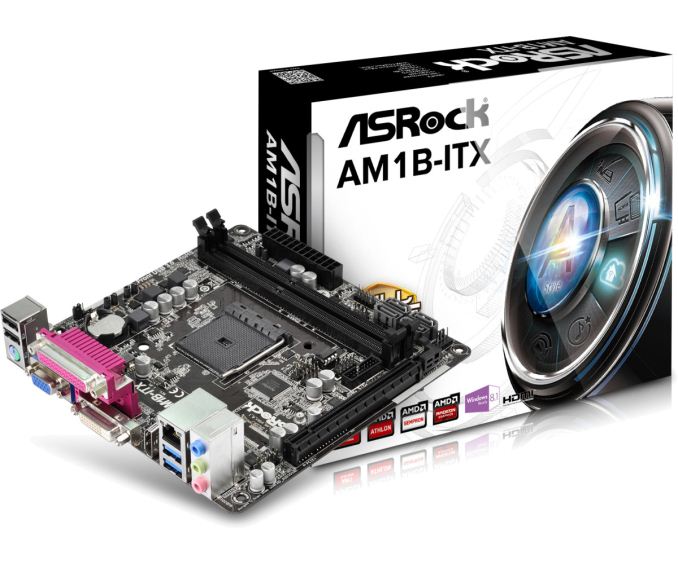The AM1 Kabini Motherboard Preview: Analyzing the Hardware
by Ian Cutress on April 19, 2014 2:00 PM ESTASRock AM1B-ITX
Moving to $40 and above brings a raft of changes – even by moving up a dollar does the AM1 landscape seem to change rapidly enough. To coin the eponymous phrase, ‘And now for something completely different’. The AM1B-ITX does what a motherboard above the base should do: add functionality and reduce complexity. Here we get double the SATA 6 Gbps ports and double the USB 3.0 ports, as well as three fan headers and an integrated parallel port on the rear panel whilst at the same time removing the need of a 4-pin CPU power connector.
ASRock has placed the 24-pin ATX connector, the four SATA 6 Gbps ports and the front panel header outside the DRAM slots (to the right), making cable management with this mini-ITX motherboard a lot easier. The SATA ports are also alternate facing to aid removal of locking SATA cables. Just inside the DRAM slots at the bottom are some of the additional headers – the COM header, the TPM header, the USB 3.0 header and two USB 2.0 headers. It might actually be a little too cramped in there.
Despite removing 4-pin CPU power connector, the top of the motherboard does look extremely busy with all the components on board. Two of the fan headers are in this area at the top left, while the third is at the bottom right. As with the other motherboards in this preview, the main PCIe 2.0 x16 slot runs at x4 mode due to the PCIe lane allocation, and of the lanes that are left ASRock has diverted one each to ASMedia controllers for the extra USB 3.0 and SATA 6 Gbps ports respectively.
While we lose the two extra USB 2.0 ports from the AM1B-M on the previous page, the rear panel gets access to more video outputs and a parallel port instead. When an antiquated port is added to a modern product, some users will bemoan its presence. More often than not, these are added because companies that use old equipment that communicates via the parallel port can cost six figures and is only updated once every few decades, so it is easier to update a $400 PC than a $400000 milling machine.
| ASRock AM1B-ITX | |
| Price | Link |
| Size | Mini-ITX |
| CPU Interface | FS1b |
| Chipset | Kabini |
| Memory Slots |
Two DDR3 DRAM slots, supporting 16 GB Single Channel, 1066-1600 MHz |
| Video Outputs |
VGA (2048x1536 at 60 Hz) DVI-D (1920x1200 at 60 Hz) HDMI (4096x2160 at 24 Hz or 3840x2160 at 30Hz) |
| Onboard LAN | Realtek RTL8111GR |
| Onboard Audio | Realtek ALC662 |
| Expansion Slots | PCIe 2.0 x16 (x4) |
| Onboard SATA/RAID |
2 x SATA 6 Gbps (Chipset) 2 x SATA 6 Gbps (ASMedia ASM1061) |
| USB 3.0 |
2 x USB 3.0 (Chipset) [back panel] 2 x USB 3.0 (ASMedia ASM1042A) [header] |
| Onboard |
4 x SATA 6 Gbps 1 x USB 3.0 Header 2 x USB 2.0 Headers 3 x Fan Headers 1 x COM Header 1 x TPM Header Front Audio Header Front Panel Header |
| Power Connectors | 1 x 24-pin ATX |
| Fan Headers |
1 x CPU (4-pin) 1 x CHA (4-pin) 1 x PWR (3-pin) |
| IO Panel |
1 x PS/2 Combination Port 1 x Parallel Port VGA DVI-D HDMI 2 x USB 2.0 2 x USB 3,0 1 x Gigabit Ethernet Audio Jacks (ALC662) |
| Product Page | Link |
Price wise, the ASRock AM1B-ITX blows the AM1B-M out of the water. For a few extra dollars there are more ports for more of the things most users will want. There is still the issue of that bottom-of-the-barrel Realtek ALC662 though.














64 Comments
View All Comments
tuxRoller - Sunday, April 20, 2014 - link
Nvidia's driver's provide performance that is pretty much identical to windows.AMD's is more variable.
From the benchmarks, there looks to be no point in going higher than an nvidia 750.
However, if you're gaming, and you want nice effects, you need that single thread performance.
Flunk - Sunday, April 20, 2014 - link
It's not like either has a very powerful GPU either. Xbox One is equivalent to a Radeon 7790 and PS4 a Radeon 7850. Plus, you don't have the CPU overhead from DirectX.Tranzz - Sunday, April 20, 2014 - link
http://semiaccurate.com/2014/04/16/adding-discrete...MonkeyPaw - Sunday, April 20, 2014 - link
Thanks. I wonder what resolution they were running. It does suggest that you can produce a mostly playable gaming setup for about $200 worth of core components. I wonder if AMD will ever scale Jaguar up even further? 8 cores and dual channel memory could be pretty potent for 50W or so. Might produce more excitement than the FX line.silverblue - Tuesday, April 22, 2014 - link
AMD obviously seems to think that a single, albeit fast, channel is enough to feed a small 'cat CPU. The trouble is, that may have been true for Brazos, but that had two cores and a weaker GPU. It'd be very interesting to see a dual channel Kabini - would it make a difference outside of GPU-based workloads?Mullins also needs a turbo mode, especially if Bay-Trail and its derivatives have one. Being able to ramp up clock speed for a short period of time so that the CPU can return to idle quicker and for longer is one of the reasons why Intel beats AMD for power consumption across the board (regardless of architecture and fab process).
FriendlyUser - Saturday, April 19, 2014 - link
You really can't beat the price. I am almost looking for an excuse to buy one...wolrah - Saturday, April 19, 2014 - link
"I never thought I would ever see a socketed motherboard in 2014 ship with a less-than-gigabit Ethernet port."I think we're at a point these days where anything new coming out with 100mbit ethernet or VGA as the primary display interface should be shunned as an outdated-out-of-the-box product.
VGA in particular, I mean who uses VGA? Even the luddites have mostly abandoned their cannonball CRTs, and a VGA-only LCD has always been the realm of idiocy.
harriharris - Sunday, April 20, 2014 - link
Not defending it myself here or anything... in fact I completely agree, but a lot of business still does. I know my workplace of over 50,000 personnel in a govt agency - every workstation I've sat at in 17 years there has had VGA connected monitors, even now with 16:10 LCDs in most places. They still run XP too... *sigh*xrror - Sunday, April 20, 2014 - link
Sadly another reason for VGA is if your building(s) with overhead projectors are wired with analog VGA. So for where I work that's maybe... 300 or so rooms rough guess.And while we've talked about changing to some sort of digital connection, fun things like HDMI copy projection, splitting to multiple projectors, etc pretty much skyrocket the already formidable costs.
So I dunno, we can't stay VGA forever (nor do we really want to) but we can't afford to switch. At all. No wonder the media services guy can't wait to retire - and I can't blame him.
tuxRoller - Saturday, April 19, 2014 - link
So, I can't get a board with displayport until we reach $50? Why? Isn't displayport royalty free?My issue is that I've a 1440p auria with both HDMI and do BUT, afaict, the HDMI interface doesn't support more than 1080p.
I really hate the HDMI spec. At least with displayport versions you know what to expect.